Pearl Millet (Pennisetum glaucum) Seedlings Transplanting as Climate Adaptation Option for Smallholder Farmers in Niger
Abstract
:1. Introduction
2. Materials and Methods
2.1. Study Area
2.2. Experimental Design
2.3. Crop Management
2.4. Data Collection
2.5. Farmers’ Perception of Pearl Millet Transplanting
2.6. Statistical Analyses
2.7. Economic Gain Analysis
3. Results
3.1. Weather Variability
Rainfall Variability Correlation with Pearl Millet Yield
3.2. Effect of Pearl Millet Transplanting on Phenology
3.3. Effect of Transplanting and NPK Application on Plant Growth Parameters
3.4. Systems Economic Gains
3.5. Farmers Perception of Pearl Millet Transplanting
4. Discussion
4.1. Transplanting to Avoid Rainfall Scarcity at the Beginning/End of Rainy Season
4.2. Transplanting for Boosting Pearl Millet Productivity and Resilience
4.3. Combined Effect of Transplanting and Fertilization on Millet Productivity and Gain
4.4. Constraints for Pearl Millet Transplanting
5. Conclusions
Author Contributions
Funding
Institutional Review Board Statement
Informed Consent Statement
Data Availability Statement
Acknowledgments
Conflicts of Interest
References
- Chouhan, M.; Gudadhe, N.; Kumar, D.; Kumawat, A.; Kumar, R. Transplanting dates and nitrogen levels influences on growth, yield attributes and yield of summer pearlmillet. BioScan 2015, 10, 1295–1298. [Google Scholar]
- Gudadhe, N.N.; Thanki, J.; Pankhaniya, R.; Usdadia, V. Feasibility of Late Transplanted Summer Pearl Millet for Prolonged rabi Season with Integrated Nitrogen Management Under Indian Coastal Region. Maydica 2020, 65, 13. [Google Scholar]
- Biswas, S. Prospects and Constraints of Transplanted Maize, Wheat, Sorghum and Pearl Millet: A Review. Int. J. Environ. Clim. Change 2020, 10, 24–43. [Google Scholar] [CrossRef]
- Lawali, M.N.; Alhassane, A.; Traoré, S.B.; Sarr, B.; Seidou, O.; Balla, A. Effets de la transplantation de jeunes plants sur la croissance et le développement du mil au Niger. Cameroon J. Biol. Biochem. Sci. 2018, 26, 6–15. [Google Scholar]
- Sehgal, D.; Rajaram, V.; Armstead, I.P.; Vadez, V.; Yadav, Y.P.; Hash, C.T.; Yadav, R.S. Integration of gene-based markers in a pearl millet genetic map for identification of candidate genes underlying drought tolerance quantitative trait loci. BMC Plant Biol. 2012, 12, 1–13. [Google Scholar] [CrossRef] [Green Version]
- Krishnan, R.; Meera, M. Pearl millet minerals: Effect of processing on bioaccessibility. J. Food Sci. Technol. 2018, 55, 3362–3372. [Google Scholar] [CrossRef] [PubMed]
- Djanaguiraman, M.; Perumal, R.; Ciampitti, I.; Gupta, S.; Prasad, P. Quantifying pearl millet response to high temperature stress: Thresholds, sensitive stages, genetic variability and relative sensitivity of pollen and pistil. Plant Cell Environ. 2018, 41, 993–1007. [Google Scholar] [CrossRef] [PubMed] [Green Version]
- Traore, B.; van Wijk, M.T.; Descheemaeker, K.; Corbeels, M.; Rufino, M.C.; Giller, K.E. Climate variability and change in southern Mali: Learning from farmer perceptions and on-farm trials. Exp. Agric. 2015, 51, 615–634. [Google Scholar] [CrossRef]
- Alvar-Beltrán, J.; Dao, A.; Dalla Marta, A.; Heureux, A.; Sanou, J.; Orlandini, S. Farmers’ perceptions of climate change and agricultural adaptation in Burkina Faso. Atmosphere 2020, 11, 827. [Google Scholar] [CrossRef]
- Moussa, S.; Tougiani, A. Farmers’ strategies for adapting to climate change in Niger. ETFRN News, December 2020. [Google Scholar]
- Mohamed, A.B.; van Duivenbooden, N.; Abdoussallam, S. Impact of climate change on agricultural production in the Sahel–Part 1. Methodological approach and case study for millet in Niger. Clim. Change 2002, 54, 327–348. [Google Scholar] [CrossRef]
- Ingram, K.; Roncoli, M.; Kirshen, P. Opportunities and constraints for farmers of West Africa to use seasonal precipitation forecasts with Burkina Faso as a case study. Agric. Syst. 2002, 74, 331–349. [Google Scholar] [CrossRef]
- Nwajei, S.E.; Omoregie, U.A.; Ogedegbe, F.O. Effects of planting dates on the growth and grain yield of two indigenous varieties of pearl millet (Pennisetum glaucum (L.) R. Br.) in a forest-savanna transition zone of Edo State, Nigeria. Acta Agric. Slov. 2019, 114, 169–181. [Google Scholar] [CrossRef] [Green Version]
- Van Ittersum, M.K.; Van Bussel, L.G.; Wolf, J.; Grassini, P.; Van Wart, J.; Guilpart, N.; Claessens, L.; De Groot, H.; Wiebe, K.; Mason-D’Croz, D. Can sub-Saharan Africa feed itself? Proc. Natl. Acad. Sci. USA 2016, 113, 14964–14969. [Google Scholar] [CrossRef] [PubMed] [Green Version]
- Alhassane, A.; Salack, S.; Ly, M.; Lona, I.; Traoré, S.B.; Sarr, B. Évolution des risques agroclimatiques associés aux tendances récentes du régime pluviométrique en Afrique de l’Ouest soudano-sahélienne. Sécheresse 2013, 24, 282–293. [Google Scholar] [CrossRef]
- Sissoko, K.; van Keulen, H.; Verhagen, J.; Tekken, V.; Battaglini, A. Agriculture, livelihoods and climate change in the West African Sahel. Reg. Environ. Change 2011, 11, 119–125. [Google Scholar] [CrossRef] [Green Version]
- Zougmoré, R.; Partey, S.; Ouédraogo, M.; Omitoyin, B.; Thomas, T.; Ayantunde, A.; Ericksen, P.; Said, M.; Jalloh, A. Toward climate-smart agriculture in West Africa: A review of climate change impacts, adaptation strategies and policy developments for the livestock, fishery and crop production sectors. Agric. Food Secur. 2016, 5, 1–16. [Google Scholar] [CrossRef] [Green Version]
- Ado, A.M.; Leshan, J.; Savadogo, P.; Bo, L.; Shah, A.A. Farmers’ awareness and perception of climate change impacts: Case study of Aguie district in Niger. Environ. Dev. Sustain. 2019, 21, 2963–2977. [Google Scholar] [CrossRef]
- Taye, M.; Simane, B.; Zaitchik, B.F.; Selassie, Y.G.; Setegn, S. Rainfall Variability across the Agro-Climatic Zones of a Tropical Highland: The Case of the Jema Watershed, Northwestern Ethiopia. Environments 2019, 6, 118. [Google Scholar] [CrossRef] [Green Version]
- Chantereau, J.; Nicou, R. Sorghum. The Tropical Agriculturalist; Macmillan Education: London, UK, 1994. [Google Scholar]
- Olabanji, O.; Tabo, R.; Flower, D.; Ajayi, O.; Ushie, F.; Kaigama, B.; Ikwelle, M. Survey of masakwa sorghum growing areas in northeastern Nigeria. Int. Sorghum Millets Newsl. 1996, 37, 61–63. [Google Scholar]
- Young, E.; Mottram, A. Transplanting Sorghum and Millet—A Key to Risk Management; Food and Agriculture Organization: Rome, Italy, 2009. [Google Scholar]
- Upadhyay, P.; Dixit, A.; Patel, J.; Chavda, J. Response of summer pearl millet (Pennisetum glaucum) to time and method of planting, age of seedling and phosphorus grown on loamy sand soils of Gujarat. Indian J. Agron. 2001, 46, 126–130. [Google Scholar]
- Singh, D.; Baghel, R.; Rajput, R.; Kushwah, S.; Rawat, G. Influence of seedling age and plant geometry on yield and uptake of nutrients in transplanted pearl millet under late sown condition. J. Multidiscip. Adv. Res. 2017, 6, 149–152. [Google Scholar]
- Young, E.; Mottram, A.; Atokple, I.; Abunyewa, A.A.; Terbobri, P.; Kasei, C. Transplanting Sorghum and Millet as a Means of Increasing Food Security in Semi-Arid, Low Income Countries; University of Wales: Bangor, UK, 2003. [Google Scholar]
- Bielders, C.L.; Gérard, B. Millet response to microdose fertilization in south–western Niger: Effect of antecedent fertility management and environmental factors. Field Crops Res. 2015, 171, 165–175. [Google Scholar] [CrossRef] [Green Version]
- Coulibaly, A.; Woumou, K.; Aune, J.B. Sustainable intensification of sorghum and pearl millet production by seed priming, seed treatment and fertilizer microdosing under different rainfall regimes in Mali. Agronomy 2019, 9, 664. [Google Scholar] [CrossRef] [Green Version]
- Maman, N.; Dicko, M.; Abdou, G.; Kouyate, Z.; Wortmann, C. Pearl millet and cowpea intercrop response to applied nutrients in West Africa. Agron. J. 2017, 109, 2333–2342. [Google Scholar] [CrossRef] [Green Version]
- Fairhurst, T. (Ed.) Manuel de Gestion Integrée de la Fertilité des Sols; Africa Soil Health Consortium: Nairobi, Kenya, 2015. [Google Scholar]
- Sogoba, B.; Traoré, B.; Safia, A.; Samaké, O.; Dembélé, G.; Diallo, S.; Kaboré, R.; Benié, G.; Zougmoré, R.B.; Goïta, K. On-farm evaluation on yield and economic performance of cereal-cowpea intercropping to support the smallholder farming system in the Soudano-Sahelian zone of mali. Agriculture 2020, 10, 214. [Google Scholar] [CrossRef]
- Devkota, M.; Yigezu, Y.A. Explaining yield and gross margin gaps for sustainable intensification of the wheat-based systems in a Mediterranean climate. Agric. Syst. 2020, 185, 102946. [Google Scholar] [CrossRef]
- Kamara, A.Y.; Ekeleme, F.; Chikoye, D.; Omoigui, L.O. Planting date and cultivar effects on grain yield in dryland corn production. Agron. J. 2009, 101, 91–98. [Google Scholar] [CrossRef]
- Soler, C.M.T.; Maman, N.; Zhang, X.; Mason, S.C.; Hoogenboom, G. Determining optimum planting dates for pearl millet for two contrasting environments using a modelling approach. J. Agric. Sci. 2008, 146, 445–459. [Google Scholar] [CrossRef]
- Fanadzo, M.; Chiduza, C.; Mnkeni, P. Comparative response of direct seeded and transplanted maize (Zea mays L.) to nitrogen fertilization at Zanyokwe irrigation scheme, Eastern Cape, South Africa. Afr. J. Agric. Res. 2009, 4, 689–694. [Google Scholar]
- Pal, M. Bajra transplanting compensates for delayed sowing. Indian Farming 1976, 25, 21–22. [Google Scholar]
- Mapfumo, S. Transplanting Soghum and Pearl Millet from Nurseries as a Means of Increasing Food Security in Semi-Arid Zimbabwe. Master’s Thesis, University of Zimbabwe, Harare, Zimbabwe, 2002. [Google Scholar]
- Jan, A.; Khan, I.; Sohail, S.A.A.A. Sowing dates and sowing methods influenced on growth yield and yield components of pearl millet under rainfied conditions. Environ. Earth Sci. 2015, 5, 105–109. [Google Scholar]
- Khairwal, I.; Rai, K.; Diwakar, B.; Sharma, Y.; Rajpurohit, B.; Nirwan, B.; Bhattacharjee, R. Pearl Millet Crop Management and Seed Production Manual; International Crops Research Institute for the Semi-Arid Tropics: Patancheru, India, 2007. [Google Scholar]
- Ajayi, O.; Labe, D. The effects of sowing date and planting method on stem borer damage in dauro millet. Ann. Appl. Biol. 1990, 117, 487–494. [Google Scholar] [CrossRef]
- Agbaje, G.; Olofintoye, J. Effect of transplanting on yield and growth of grain sorghum (Sorghum bicolor (L.) Moench). Tropicultura 2002, 20, 217–220. [Google Scholar]
- Assefa, D.; Belay, M.; Tsegay, D.; Haile, M. Transplanting Sorghum as a Means of Ensuring Food Security in Low Rainfall Sorghum Growing Areas of Northern Ethiopia; Drylands Coordination Group (DCG) report No. 48; Miljøhuset G9: Asmara, Ethiopia, 2007. [Google Scholar]
- Oswald, A.; Ransom, J.K.; Kroschel, J.; Sauerborn, J. Transplanting maize and sorghum reduces Striga hermonthica damage. Weed Sci. 2001, 49, 346–353. [Google Scholar] [CrossRef]
- Bationo, A.; Christianson, C.; Mokwunye, U. Soil fertility management of the pearl millet producing sandy soils of Sahelian West Africa: The Niger experience. In Proceedings of the International Workshop on Soil, Crop, and Water Management Systems for Rainfed Agriculture in the Sudano-Sahelian Zone, Niamey, Niger, 11–16 January 1987; International Crops Research Institute for the Semi-Arid Tropics: Patancheru, India, 1989. [Google Scholar]
- Obwocha, E.B.; Ramisch, J.J.; Duguma, L.; Orero, L. The Relationship between Climate Change, Variability, and Food Security: Understanding the Impacts and Building Resilient Food Systems in West Pokot County, Kenya. Sustainability 2022, 14, 765. [Google Scholar] [CrossRef]
- Silungwe, F.R.; Graef, F.; Dorothea Bellingrath-Kimura, S.; Chilagane, E.A.; Tumbo, S.D.; Kahimba, F.C.; Lana, M.A. Modelling rainfed pearl millet yield sensitivity to abiotic stresses in semi-arid central Tanzania, Eastern Africa. Sustainability 2019, 11, 4330. [Google Scholar] [CrossRef] [Green Version]
- Traore, B.; Van Wijk, M.T.; Descheemaeker, K.; Corbeels, M.; Rufino, M.C.; Giller, K.E. Evaluation of climate adaptation options for Sudano-Sahelian cropping systems. Field Crops Res. 2014, 156, 63–75. [Google Scholar] [CrossRef]
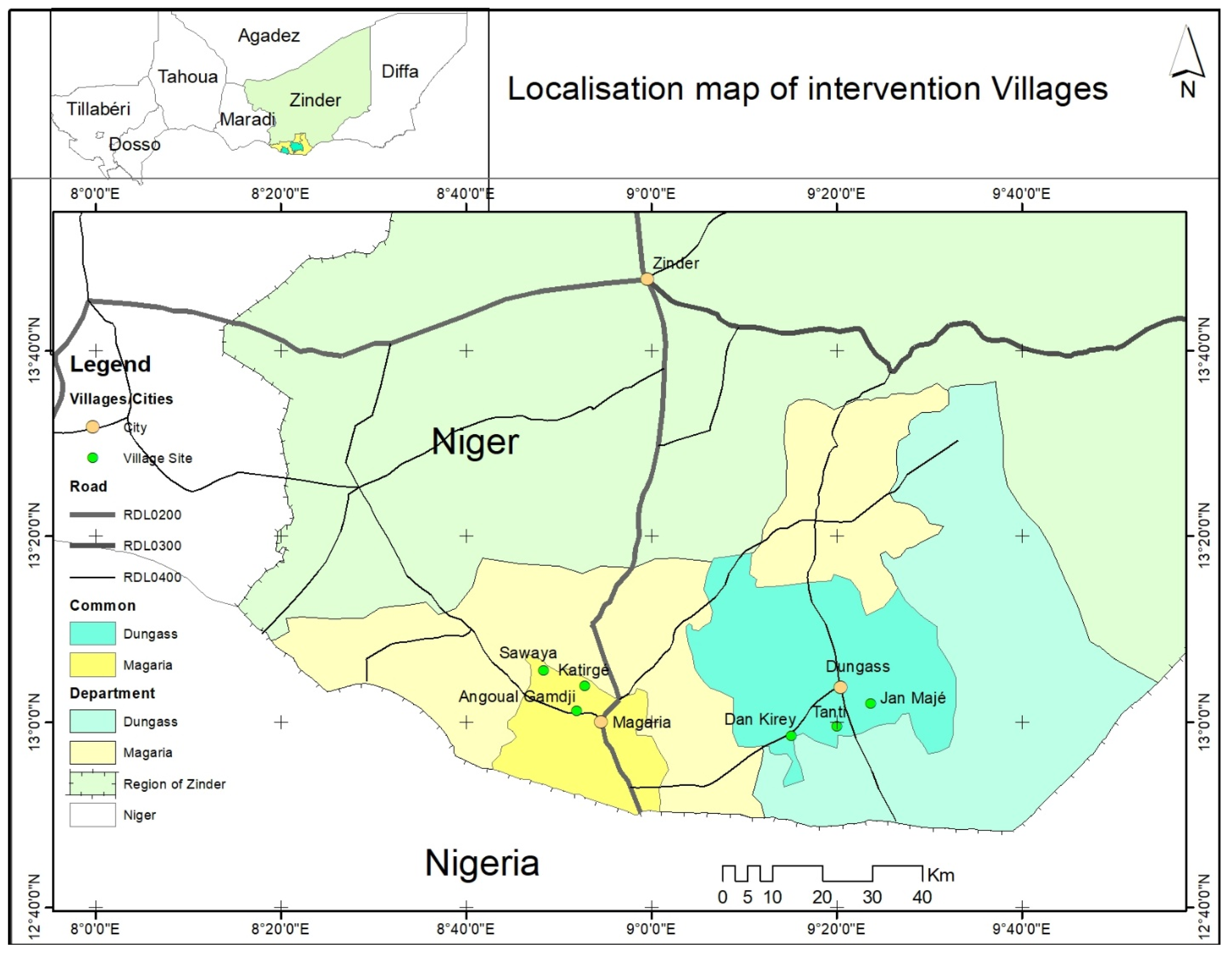
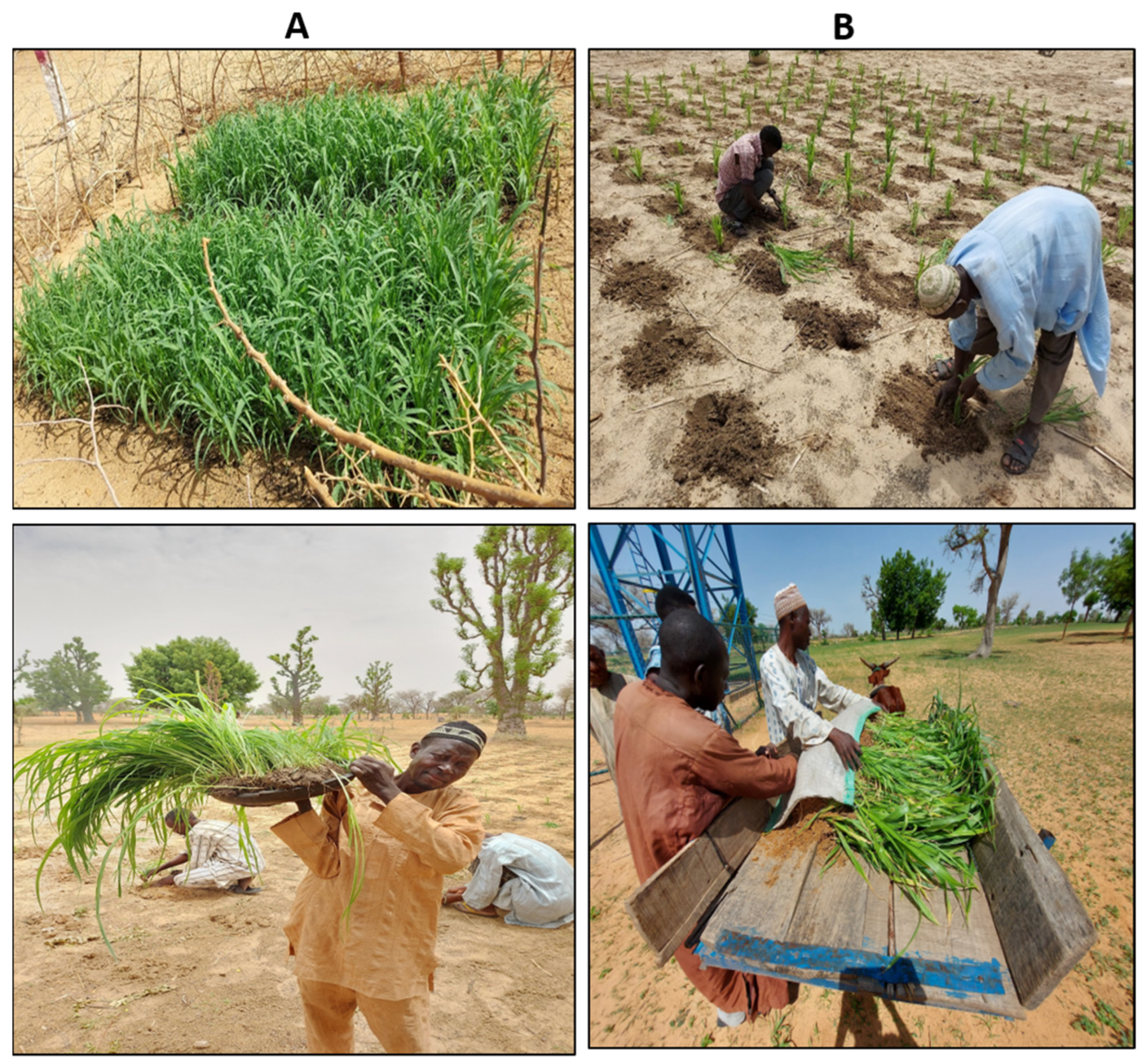

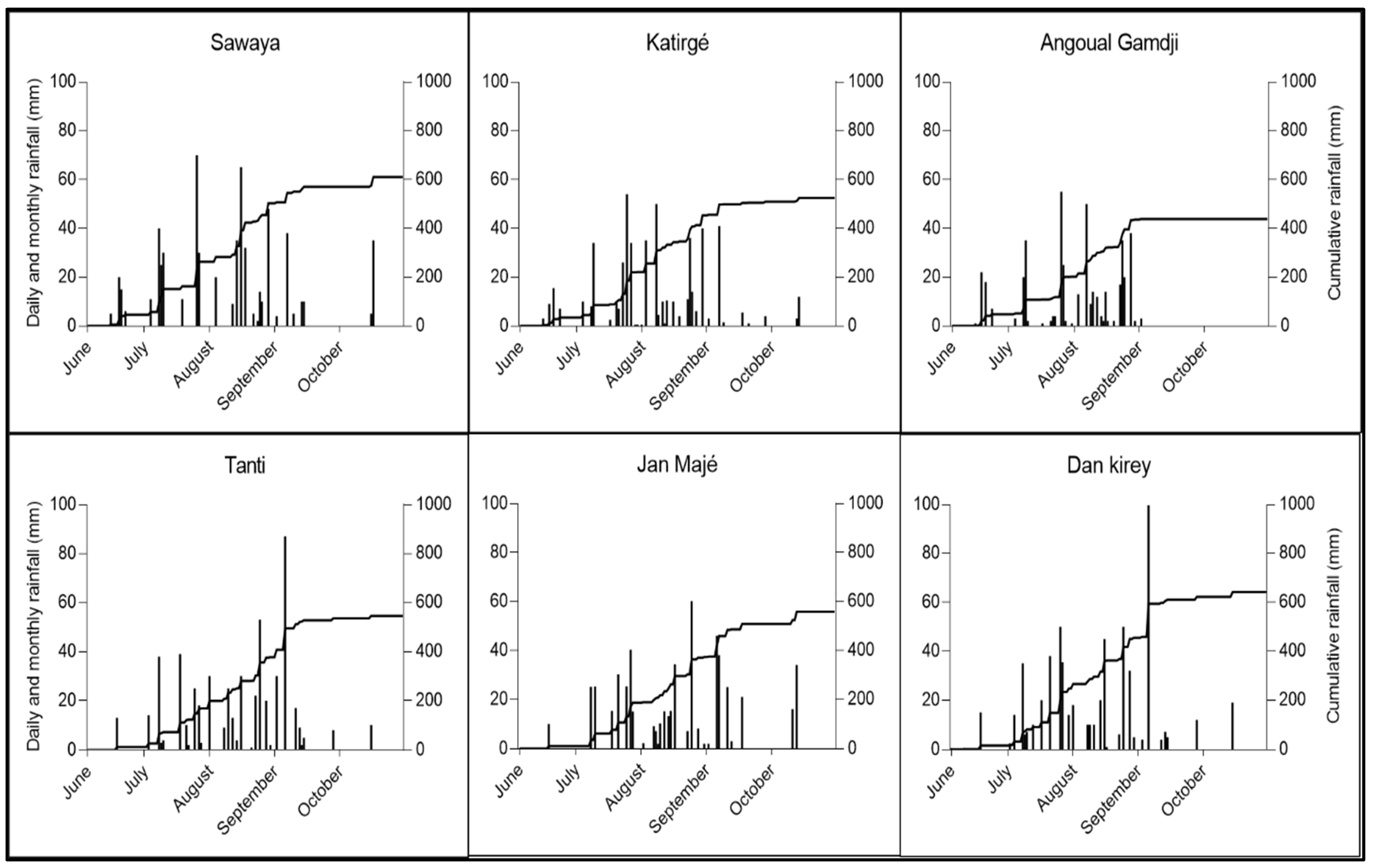

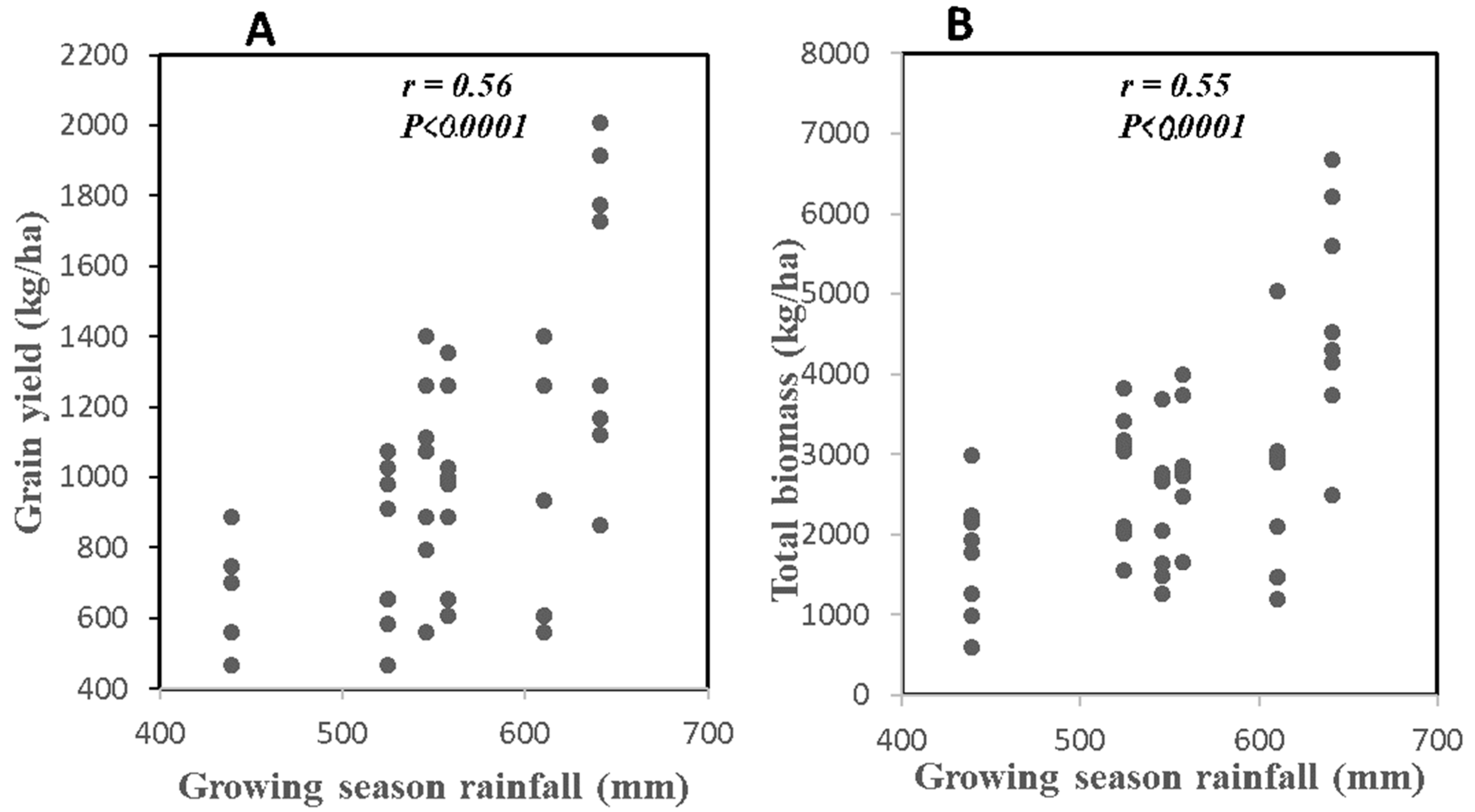
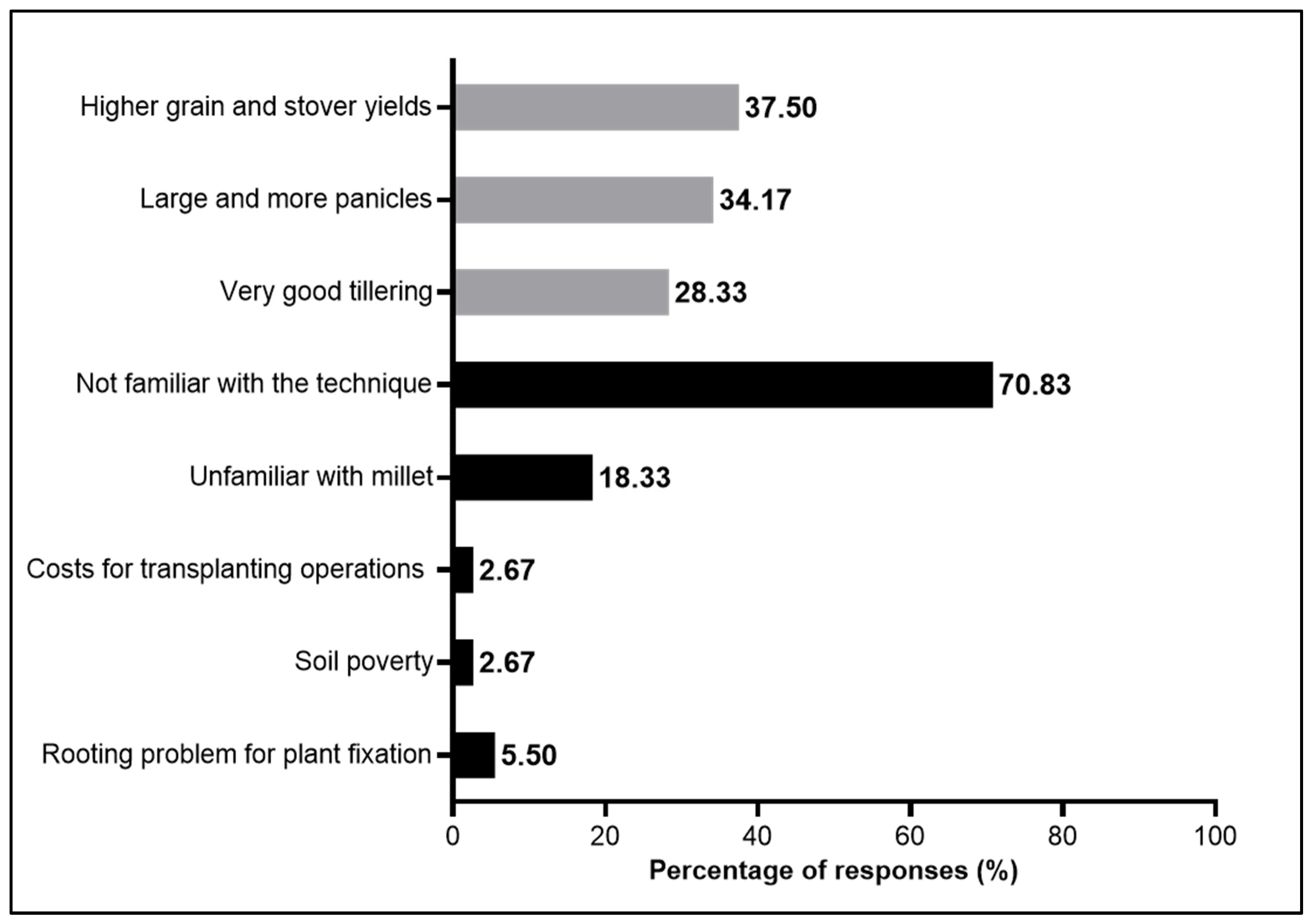
| Operations | Katirgé | Sawaya | A. Gamdji | Dan Kirey | Tanti | Jan Majé |
|---|---|---|---|---|---|---|
| Setting of nursery | 2 June 2021 | 2 June 2021 | 2 June 2021 | 31 May 2021 | 31 May 2021 | 31 May 2021 |
| Planting | 4 July 2021 | 4 July 2021 | 4 July 2021 | 5 July 2021 | 5 July 2021 | 5 July 2021 |
| Transplanting | 9 July 2021 | 9 July 2021 | 9 July 2021 | 10 July 2021 | 10 July 2021 | 10 July 2021 |
| Transplanting of empty holes | 27 July 2021 | 27 July 2021 | 27 July 2021 | 29 July 2021 | 29 July 2021 | 29 July 2021 |
| Thinning | 11 July 2021 | 13 July 2021 | 16 July 2021 | 14 July 2021 | 14 July 2021 | 14 July 2021 |
| NPK application | 26 July 2021 | 27 July 2021 | 27 July 2021 | 29 July 2021 | 29 July 2021 | 29 July 2021 |
| First weeding | 12 July 2021 | 17 July 2021 | 15 July 2021 | 12 July 2021 | 14 July 2021 | 12 July 2021 |
| Second weeding | 4 August 2021 | 7 August 2021 | 2 August 2021 | 8 August 2021 | 5 August 2021 | 3 August 2021 |
| Mode of Planting | 50% Tillering | 50% Flowering | 50% Maturity |
|---|---|---|---|
| T1 | 14 b | 35 b | 59 b |
| T2 | 19 a | 61 a | 74 a |
| T3 | 19 a | 61 a | 74 a |
| T4 | 19 a | 61 a | 74 a |
| SD | 2.88 | 0.42 | 5.24 |
| CV (%) | 16.81 | 1.20 | 7.51 |
| p.value | 0.014 | <0.0001 | <0.0001 |
| Treatments | Plant Density (Plants/ha) | Panicle Weight (kg/ha) | Total Biomass (kg/ha) | Grain Yield (kg/ha) | Plant Height (m) | Tiller Number |
|---|---|---|---|---|---|---|
| T1-NPK | 58,800 a | 2636.67 a | 4176.67 a | 1275.56 a | 1.62 a | 5.98 c,d |
| T1-0NPK | 56,233.33 a,b | 1625.56 b | 2498.89 c | 871.11 c,d | 1.66 a | 5.53 d |
| T2-NPK | 58,800 a | 1594.44 b | 3087.78 b | 1065.56 a,b,c | 1.30 b | 7.53 b |
| T2-0NPK | 56,700 a | 1322.22 c,d | 2822.78 b,c | 706.67 d | 1.04 c,d | 6.62 c |
| T3-NPK | 55,300 a,b,c | 1625.56 b | 3406.67 b | 1104.44 a,b | 1.03 c,d | 8.76 a |
| T3-0NPK | 50,166.67 b,c,d | 1067.22 e | 1758.33 d | 722.78 d | 0.92 d | 5.43 d |
| T4-NPK | 47,833.33 d | 1442.78 b,c | 2925 b,c | 890.56 b,c,d | 1.11 c | 7.54 b |
| T4-0NPK | 49,466.67 c,d | 1127.78 d,e | 1866.67 d | 727.22 d | 1.02 c,d | 6.64 c |
| p.value | 0.164 | <0.0001 | 0.021 | 0.001 | <0.0001 | <0.0001 |
| SD | 6531.5 | 488.1 | 1146.8 | 403.2 | 0.7 | 3.7 |
| CV (%) | 12.88 | 34.38 | 42.14 | 45.73 | 57.63 | 54.70 |
| Mode of planting | 0.001 | <0.0001 | 0.001 | 0.015 | <0.0001 | <0.0001 |
| Fertilization | 0.186 | <0.0001 | <0.0001 | <0.0001 | 0.024 | <0.0001 |
| Mode of planting × Fertilization | 0.465 | <0.0001 | 0.008 | 0.343 | 0.127 | <0.0001 |
| Treatments | Total Cost | Gross Margin Biomass | Gross Margin Grain |
|---|---|---|---|
| T1-NPK | 58,280 | 359,387 | 324,388 |
| T1-0NPK | 23,000 | 226,889 | 238,333 |
| T2-NPK | 53,280 | 255,498 | 266,388 |
| T2-0NPK | 18,000 | 264,278 | 194,001 |
| T3-NPK | 52,280 | 288,387 | 279,052 |
| T3-0NPK | 17,000 | 158,833 | 199,834 |
| T4-NPK | 45,280 | 247,220 | 221,888 |
| T4-0NPK | 10,000 | 176,667 | 208,166 |
Publisher’s Note: MDPI stays neutral with regard to jurisdictional claims in published maps and institutional affiliations. |
© 2022 by the authors. Licensee MDPI, Basel, Switzerland. This article is an open access article distributed under the terms and conditions of the Creative Commons Attribution (CC BY) license (https://creativecommons.org/licenses/by/4.0/).
Share and Cite
Traore, B.; Moussa, A.A.; Traore, A.; Abdel Nassirou, Y.S.; Ba, M.N.; Tabo, R. Pearl Millet (Pennisetum glaucum) Seedlings Transplanting as Climate Adaptation Option for Smallholder Farmers in Niger. Atmosphere 2022, 13, 997. https://doi.org/10.3390/atmos13070997
Traore B, Moussa AA, Traore A, Abdel Nassirou YS, Ba MN, Tabo R. Pearl Millet (Pennisetum glaucum) Seedlings Transplanting as Climate Adaptation Option for Smallholder Farmers in Niger. Atmosphere. 2022; 13(7):997. https://doi.org/10.3390/atmos13070997
Chicago/Turabian StyleTraore, Bouba, Abdourazak Alio Moussa, Amadou Traore, Yahaya Seydou Abdel Nassirou, Malick N. Ba, and Ramadjita Tabo. 2022. "Pearl Millet (Pennisetum glaucum) Seedlings Transplanting as Climate Adaptation Option for Smallholder Farmers in Niger" Atmosphere 13, no. 7: 997. https://doi.org/10.3390/atmos13070997
APA StyleTraore, B., Moussa, A. A., Traore, A., Abdel Nassirou, Y. S., Ba, M. N., & Tabo, R. (2022). Pearl Millet (Pennisetum glaucum) Seedlings Transplanting as Climate Adaptation Option for Smallholder Farmers in Niger. Atmosphere, 13(7), 997. https://doi.org/10.3390/atmos13070997






